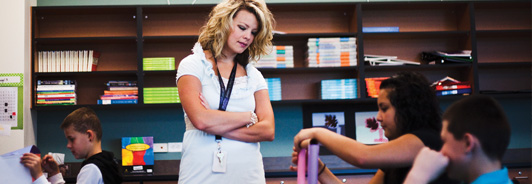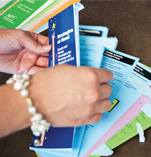Practical Strategies for Teaching Students with Autism
UNC faculty provide trusted tools backed by research in a set of two easy-to-use booklets for educators and parents
Story by Anne Cumming Rice / Photos by Eric Bellamy
During Logann Grasteit’s first year of teaching, she had a student with autism who had some significant behavior issues that made her seek out help. She turned to something she’d been introduced to as an undergraduate in UNC’s Special Education program — two booklets by associate professors Robin Brewer and Tracy Mueller that offer quick, handy strategies for those working with students with autism.
“There are a lot of challenges working with autistic kids,” says Grasteit (BA-09), who is in her fourth year teaching at Otho E. Stuart Middle School in Commerce City. “Some things are not common sense to them, and you have to teach them those things.”
The prevalence of autism spectrum, a broad term for a group of complex disorders of brain development, has increased tenfold during the past 40 years. The increase is only partly explained by improved diagnosis and awareness, according to the nonprofit organization Autism Speaks.
“The autism spectrum can include kids with very significant disabilities, to kids who are extremely bright and fixate on an area of interest but have trouble with social
communication,” Brewer says.
At UNC, Brewer and Mueller developed Strategies at Hand in response to the growing number of kids with autism and the confusion surrounding autism spectrum disorder.
“We were on an autism task force, and there was talk about having a useful tool for teachers,” Brewer says. “Teachers don’t have the time to read research journal articles, and the Internet can be a scary thing when it comes to finding reliable help.”
The two booklets — more aptly described as a stack of bookmarks one can flip through — contain evidence-based strategies for everything from field trips and cafeterias to behavior issues and fire drills. Strategies are presented in a simple, bullet-point style designed for quick reading.
Backed up by research
Evidence-based means the strategies are backed by research. That’s important to Grasteit, who works with her students on math, reading, writing and life skills. Her students attend electives, social studies and science classes in general education classrooms, oftentimes with a paraeducator on hand to help them. The goal at most public schools is to include special education students in general education classrooms as much as possible, depending on each student’s individual needs.
“I thought it would be in my best interest to use research-based strategies with my students and not just pull stuff out of the woods,” says Grasteit, who returned to UNC last year to get her graduate certificate in autism through UNC’s online program. “You just don’t want to be wasting anyone’s time with strategies that haven’t been proven to work.” What to believe and trust has been an issue with autism research, from what causes it to how to manage it once it’s diagnosed.
“It seems like there’s a new headline every day about autism,” Brewer says. “Our society is all about quick, instant anything. So you watch a show on Dateline and you think, ‘OK, I’ll try it. I’ll do anything to solve this issue.’ ”
The belief that immunizations cause autism (perpetuated by everyone from Hollywood stars and politicians) stemmed from a now-fraudulent 1998 British study. But the damage was done, and to this day, according to one survey, one in four American parents still believes immunizations cause autism.
“That kind of thing just stains the whole field,” Mueller says. “It was a totally false presumption.”
The latest research shows autism has its roots in early brain development and appears to be connected with gene mutations and environmental stresses that happen prenatally and during birth, according to Autism Speaks.
“You keep hearing that autism is the ‘it’ disability right now,” Mueller says. “And you get the feeling that it’s this growing epidemic. But it’s always been there. We’re getting awfully good at identifying autism, but we also over-identify it as well. Once you have the label, ‘autism,’ you have it for life.”
Regardless, schools don’t focus on the label but develop individualized programs based on what a student needs to learn and be successful to comply with the Rehabilitation Act of 1973, which requires school districts to provide a “free appropriate public education” to all children with identified disabilities.
Helpful for parents
All the confusion about autism made developing a simple, reliable tool important to Mueller and Brewer. The first Strategies at Hand for use with students with autism was published in 2008. In 2010, another booklet was published, offering behavior strategies for use in all classrooms.
One of Grasteit’s greatest challenges is getting parents to reinforce at home what she is trying to do in the classroom. She says the strategies in the handbooks can help parents, too.
“My personal goal is to get my students to be as independent as possible,” she says. “For a lot of families, their goal is to get their child to communicate more with them. Of course, communication is a key to greater independence.” NV
—Anne Cumming Rice is a freelance writer in Denver and former college journalism instructor.
More Information:
Tips to Recognize Early Signs of Autism
Excerpts from Strategies at Hand: Quick and Easy Strategies for Working with Students
on the Autism Spectrum
More about UNC’s Autism Graduate Certificate: Teaching Students with Autism
Spectrum Disorders







